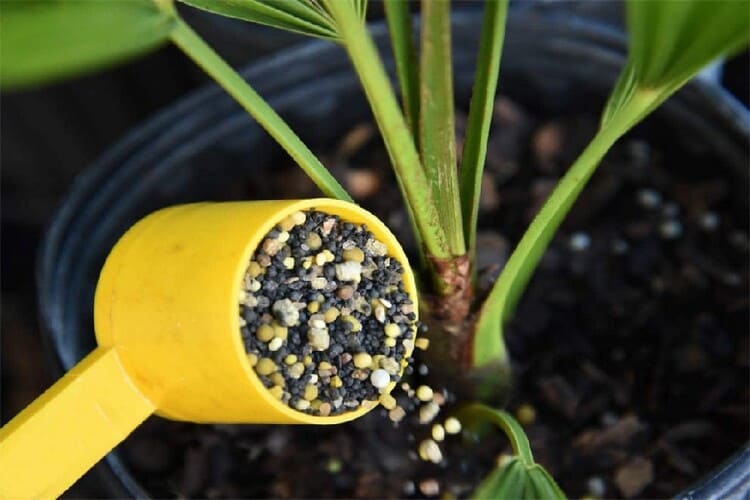Sign up for our newsletter
Get Swipe Garden's independent reviews, and expert advice sent straight to your inbox.
For information privacy practices, read our Privacy Policy.
Sign up for our newsletter
Get Swipe Garden's independent reviews, and expert advice sent straight to your inbox.
For information privacy practices, read our Privacy Policy.
Sign up for our newsletter
Get Swipe Garden's independent reviews, and expert advice sent straight to your inbox.
For information privacy practices, please read our Privacy Policy.

Palm trees are a popular specimen plant throughout Florida, Louisiana, and other similar regions due to their tropical, exotic look. Experienced farmers will know these plants are heavy feeders, and the sandy, calciferous soil can’t always accommodate their nutritional demands. If you plan to grow a palm tree in your garden, one question you should know is, “When should you fertilize palm trees?”
You’ll need to feed palm trees two to three times per year during the season (from March to October) with manure specifically formulated for palms. Keep reading to learn more about palm tree fertilization with Swipe Garden!
The recommended period to fertilize palm trees is from March to October. Since the growing season starts in March, this is the best time to feed your palms and other herbs and shrubs in your landscape. If your living area has warm climates and the temperatures rarely drop too low, you may need to fertilize your trees three to four times per year.
In regions with year-round chilly weather, you’d better stop feeding them a couple of months prior to the first frost snap. Some beginner gardeners believe that applying palm fertilizer during the cold season can help strengthen the plants and make them ready to thrive in the growing season in the spring.
Indeed, winter is the wrong time for palm fertilizer application. The new growth promoted will weaken the tree and make it vulnerable to harsh weather conditions. If you’ve just planted palms, don’t feed them until they produce a new shoot—around two months after planting. Unlike newly planted trees, you can follow the normal feeding schedule for mature palms.
The frequency of fertilization largely depends on the amount of rainfall in your area and the type of soil. Slow-release fertilizers are best for fertilizing palm trees since they release nutrients slowly over time, reducing the possibility of leaching. In Florida, the downpours are heavy, and the soil is calciferous and sandy during the growth season. Thus, the pool of crucial nutrients is pretty low.
Nutrients will quickly leach from sandy soil due to heavy rainfall. Therefore, you’ll need to apply fertilizer two to three times per year to maintain an adequate nutrient level. In areas where soils have better quality and rainfall is lower, like California, you can fertilize the soil two to three times per year.
Additionally, you can use palm fertilizer for other plants. Just be sure to follow the directions on the fertilizer label and dilute it according to the type of plant you are fertilizing.
You should water newborn palms every day in the first week, every other day in the next week, and three times in the third week. After the first three weeks, start to water as you normally do for mature plants.
Treat your established greenery with water two to three times a week, only during periods of low rainfall. For most palms, you should water only when the 2-inch top of the soil is drained.
Most of the growth occurs in the warm months of summer, so palms will need plenty of humidity to accommodate the energy needed for growth. Usually, rainfall is low in the summer. The farmer should water their trees regularly during this time to retain adequate moisture content underneath the soil.
You will rarely notice much growth during the winter, so the water levels should also be reduced during this period. In winter, plants need warmth, while water will cool the surface. Thus, water is available at times when there is little rainfall.
Here are step-by-step instructions to keep your trees green and fix your palm’s yellow tint:
As palm trees grow, old leaves may naturally change to yellow and drop off. Provided that the majority of the tree fronds stay green, there’s no need to worry.
However, if you notice that the problem is lingering, it might be a red flag. The major reasons palm leaves turn yellow are nutrient deficiency, improper light, and pest infestation. Notably, the lack of minerals and nutrients, including nitrogen, magnesium, manganese, potassium, and iron, is possibly the most well-known cause of yellow leaves.
Learning about “When should you fertilize palm trees?” is critical to your palm tree’s success. You can easily prevent palm nutritional deficiency and ensure green, thriving plants as long as you stick to an annual fertilization programme. Swipe Garden hopes to see your charming garden.
Thank you for reading!